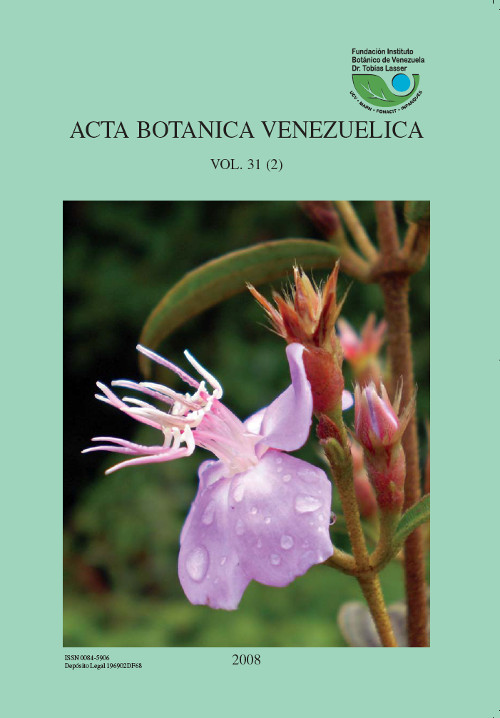EFICIENCIA REPRODUCTIVA DE CLONES DE PACHIRA QUINATA (JACQ.) W. ALVERSON (BOMBACACEAE) BAJO CONDICIONES DE CULTIVO
Resumen
RESUMEN
La eficiencia reproductiva de clones de Pachira quinata fue evaluada bajo condicionesde cultivo en los jardines y huertos Clonales Semilleros de El IREL, Barrancas, estado Barinas,Venezuela. Cuatro variables de eficiencia reproductiva fueron consideradas: aborto desemillas, producción de semillas por óvulo, producción de frutos por flor y fecundidad relativa,esta última expresada como el número de semillas viables producidas por óvulos por inflorescencia.Cada una de las variables fue determinada para cada clon y luego comparada deacuerdo a la procedencia de los clones (cuatro venezolanas y cuatro centroamericanas). Elimpacto del porcentaje de semillas abortadas sobre la producción total de semillas es altamentevariable (1,3-29,2%), aunque la mayoría de los valores porcentuales de semillas abortadaspor fruto fue inferior a 20%, con un valor promedio de 10,9%. La producción de semillaspor óvulo fue inferior a 50% (20,3-49,5%) con un promedio de 33,7 semillas por óvulo.La relación fruto/flor varió entre 7,1 y 50,0%, sin embargo, la mayoría de los valores están alrededorde 20%. La fecundidad relativa varió entre 3,7 a 14,5% ( = 6,6%). La producción defrutos por flor y la fecundidad relativa fueron las únicas variables estadísticamente diferentesentre procedencias. De los resultados de la matriz de correlación destaca que 60,8% de la varianzaen la fecundidad es explicada por la producción de frutos por flor. De acuerdo a informaciónde estudios previos, los resultados obtenidos en la eficiencia reproductiva pueden serasociados a la autoincompatibilidad genética, limitación de polinizadores, limitación de recursosy la vecindad de ramets de los mismos clones en la plantación.
ABSTRACT
The reproductive efficiency of clones of Pachira quinatawas evaluated under cultivationconditions in the garden and seed clonal orchards at El IREL, Barrancas, State Barinas, Venezuela. Four variables of reproductive efficiency were considered: abortion of seeds, productionof seeds by ovule, production of fruits by flower and the relative fecundity, which isexpressed as the number of good seeds produced by ovule by inflorescence. Each one of thesevariables was determined for each clone and then compared according to the origin of theclones (four of Venezuelan origin and four of Central American origin). The percentage ofseeds aborted by fruit shows that the impact on the total production of seed set is highly variable(1.3-29.2%), although most of the percentage values of seeds aborted by fruit were inferiorto 20%, with an average value of 10.9%. The production of seeds by ovule was from 20.3to 49.5% with an average of 33.7% seeds per ovule. The relation fruit/flower was low and variedbetween 7.1 and 50.0%, nevertheless, most values of fruit production were around 20%.The relative fecundity varied from 3.7 to 14.5%, averaging 6.61%. The production of fruitsper flower and the relative fecundity were the only reproductive variables statistically differentamong clone origins. According to the results of correlation matrix, 60.8% of the variancein the fecundity is explained by the production of fruits per flower. According to the informationof previous studies, the results obtained in the reproductive efficiency may be associatedto the genetic self incompatibility, pollinator limitation, resource limitation and the neighborhoodof ramets of the same clones in the plantation.
Descargas
Descargas
Número
Sección
Licencia
© Instituto Experimental Jardín Botánico "Dr. Tobías Lasser" |


